Tips for choosing and installing a greenhouse irrigation system (5 irrigation options)
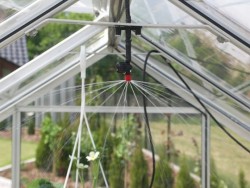 The main task for gardeners is to provide the soil with the optimal amount of water. From the solution of this problem depends not only the quality of the crop, but also the viability of the plants, the complexity of the glaze and other.
The main task for gardeners is to provide the soil with the optimal amount of water. From the solution of this problem depends not only the quality of the crop, but also the viability of the plants, the complexity of the glaze and other.
In our article we will talk about varieties automatic watering in the greenhouse, about the pros and cons of a particular type of irrigation. We will provide tips and advice on the selection and installation of an irrigation system for a greenhouse.
Autowatering It is a set of specialized equipment with the help of which high-quality water supply of a certain territory is carried out greenhouses or a greenhouse. This type of irrigation is considered multifunctional, rational, the most modern and suitable for each individual plant.
Basic principles of designing and arranging a greenhouse irrigation system
When planning a future automatic irrigation in a greenhouse, landscape features and the area of the greenhouse - a visual assessment of the agro-site, taking into account the topography of the area, a map of the adjacent territory, if you wish, you can use the dendroplan.
It is quite possible to make watering in the greenhouse with your own hands, but you must keep in mind the following nuances:
 select kind of control automatic watering systems - manual, long-range (remote) or fully automated;
select kind of control automatic watering systems - manual, long-range (remote) or fully automated;- size of watering areaa - full water irrigation or partial;
- cost - thorough irrigation of all growing crops, a specific section of the greenhouse or selective irrigation with water, with a clearly regulated automatic irrigation program and depending on the number of sprinklers;
- the choice type of moisture supply - drip, underground (complex) or sprinkling.
Greenhouse watering options
Today, there are three leading irrigation systems for the greenhouse: rain, drip and subsoil. These systems are united by the fact that watering in the greenhouse is automatic. After all, you can still traditionally water the plants using hand watering cans.
Autowatering of the greenhouse by sprinkling
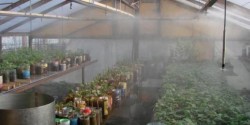 Rain type irrigation - The most simple and popular of those used in greenhouses. The whole system is located at the top. greenhouses and consists of a small number of sprayer inlets, and simulates rain droplets. Also, such sprinklers can be located at the level of the soil.
Rain type irrigation - The most simple and popular of those used in greenhouses. The whole system is located at the top. greenhouses and consists of a small number of sprayer inlets, and simulates rain droplets. Also, such sprinklers can be located at the level of the soil.
Sprayers come in stationary, stably fixed, and turning around its axis. The second have a more complex structure and evenly distribute water throughout the territory.
The advantages of such a system include the fact that watering is carried out by one sprinkler and covers a large area.
The disadvantages of sprinkling include:
- the possibility of waterlogging in the greenhouse;
- drops of water located on the leaves of crops can cause “sunburn”;
- too painstaking process - after the watering is finished, you need to shake off the drops from all the bushes;
- for the functioning of a rampant system you need a strong pressure of water - you have to spend money on expensive material proper installation;
- inefficient waste of water - a certain fraction evaporates and does not feed the root system of the flora;
- with the help of such rain irrigation, fertilizing into the ground is impossible.
Aerosol type automatic irrigation in the greenhouse (deluge)
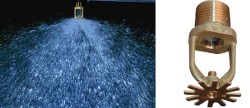 A variant of the sprinkler irrigation system is deluge irrigation using a powerful motor. Water passes through pipes and rushes in through small-diameter nozzles with sprinklers.
A variant of the sprinkler irrigation system is deluge irrigation using a powerful motor. Water passes through pipes and rushes in through small-diameter nozzles with sprinklers.
For installation of foggy automatic irrigation in a greenhouse, deluge sprinklers, which are used in automatic devices, are usually used fire extinguishing.
The aerosol type of irrigation in the greenhouse has narrow focus - for growing tropical plants that love wet rain "weather", for example, orchids. Such a system can be used when distilling seedlings in the soil.
The main advantages of deluge irrigation:
- during irrigation, the temperature of the plants decreases and the room cools;
- soil is exchanged (aeration); watering does not form a crust (hard crust);
- an impressive reduction in water consumption;
- uniform water distribution in the greenhouse or greenhouse;
- if necessary, disinfection of cultivated plants and the room itself, thanks to deluge nozzles, this process occurs quickly and thoroughly.
Intra-soil automatic greenhouse irrigation system
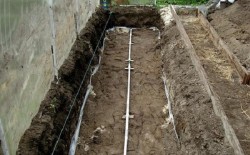 The structure of the system is similar to drip irrigation, but the pipes are under the ground and thereby the moisture is delivered directly to the roots of the plants.
The structure of the system is similar to drip irrigation, but the pipes are under the ground and thereby the moisture is delivered directly to the roots of the plants.
The underground irrigation system is considered the most efficient and at the same time laborious in the installation of automatic irrigation, and forces the gardener to participate personally.
How to make watering in a greenhouse yourself? This is not difficult. First of all, the gardener will have to make indentations in the ground and tirelessly control this process. It is also possible to combine watering with fertilizing plants with various fertilizers.
The benefits of underground irrigation include:
- enrichment of the soil with air microbubbles (aeration);
- economical water consumption;
- provides a constant level of humidity in the greenhouse, which has a beneficial effect on plant health and protects them from putrefactive diseases.
Intrasoil simplified greenhouse irrigation
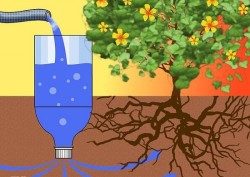 The arrangement of the greenhouse with this type of irrigation occurs in a simplified way by digging in several (or one) containers having openings (holes). Usually, hybrid installation methods are used for these purposes - an ideal and not so expensive option using plastic containers, plastic cans or cuts of perforated pipes are taken. Tanks are immersed in the soil to the very neck.
The arrangement of the greenhouse with this type of irrigation occurs in a simplified way by digging in several (or one) containers having openings (holes). Usually, hybrid installation methods are used for these purposes - an ideal and not so expensive option using plastic containers, plastic cans or cuts of perforated pipes are taken. Tanks are immersed in the soil to the very neck.
It is clear that the waste in this case will be minimal. This method of irrigation is considered the cheapest and requires minimal costs for plastic bottles. Simplified underground irrigation is not entirely automatic - the gardener will still have to periodically fill containers dug into the ground with water.
Greenhouse drip irrigation system
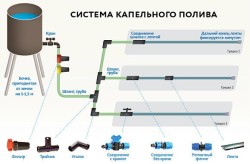 Drip irrigation, today, is considered the most rational, affordable, profitable and progressive method of irrigation.
Drip irrigation, today, is considered the most rational, affordable, profitable and progressive method of irrigation.
Through the main pipeline from the source, water is supplied to special tapes and droppers, thanks to which it enters the soil “targeted”, directly to the roots of the vegetation. Maximum moisture saturation occurs. Due to the fact that there is an increased amount of water in the earth, plants do not need to be afraid of sudden frosts.
It is quite possible to make drop watering in a greenhouse with your own hands. All hosesby means of which water supply is carried out, is placed on the surface of the soil, or inside it.A distinctive feature of drip irrigation is that the portion of water entering the plants is small and is supplied with a slight water pressure.
Drop watering in a greenhouse has many advantages:
- increases the amount of harvest;
- the soil is not waterlogged, there is no dampness, hard crusts do not form, it is not necessary to aerate and loosen the earth all the time;
- light and simple fertilizing with fertilizers - their uniform delivery to all green crops;
- there is no condition for weed growth - the maintenance of the territory is facilitated;
- does not need a large water pressure;
- lean water consumption - about 30% of water is saved in comparison with traditional watering.
It is necessary to list the disadvantages of drip irrigation:
- irrigation system complexity;
- fairly high cost;
- the need to carefully monitor the purity of water and prevent contamination of drip tapes.
DIY drip irrigation of the greenhouse (installation from improvised means)
Device drip irrigation system
Installation of drip irrigation can be carried out without special skills. For this process, you will need such consumables:
- Hoses The optimum thickness of the product is 8 mm. This length is enough to water for a distance of 25 meters from the junction;
- A variety of fittings. These include - corners, plugs, tees, crosses. All of these elements have cones on the connections, and they are easily coupled to polymer hoses without the use of special building tools. Such compounds withstand water pressure of 3 atm;
- Devices that relieve pressure: anti-drainage valves, mini-cranes, gearboxes. Reduce the pressure of the water flow in the pipes about 2 meters 1.4 atm. Typically, such devices are used to smooth the pressure and evenly distribute the water in an automatic system;
- Tips. The part required to supply moisture from the main hydraulic hose directly to the rhizomes of plants. Tips are divided into simple and labyrinth. The first ones are adapted for irrigation of one node, and the second ones evenly direct moisture to several points (about 3-5).
You should get these tools:
- shovel;
- hole puncher;
- pneumatic punch;
- hammer drill;
- pliers;
- roulette;
- set of keys;
- puncher;
- pipe cutters;
- scissors for plastic.
Steps for installing an irrigation system for a greenhouse:
- laying a ditch-trench for the future pipeline;
- direct installation of the pipeline;
- installation of additional special equipment depending on the type of irrigation - droppers and tapes, sprayers, automatic taps;
- connection of parts of the auto irrigation system and automation;
- installation of a pressure head hydraulic system for automatic irrigation in a greenhouse;
- at the end of the installation, a test of the irrigation system made is mandatory.
The main components and description of the operation of the automatic irrigation system in the greenhouse:
- A source, namely, well, well, reservoir, water pipes. Watering too cold water can cause hypothermia of plants, a kind of "stress", which will negatively affect the general development of the flora and, accordingly, yield. Therefore, the temperature of the supplied water should be the same as the temperature of the air;
- Pump. The element that creates the desired pressure in the system. It is necessary if the source of water is a tank, well, reservoir. Water supply requires a pressure reducer, as most often it is unstable and unsafe for pipes, droppers and tapes;
- Filter. Mandatory part at the inlet of the irrigation system, independent of the selected water source. With absence filter the system will immediately fail and require thorough cleaning;
- Solenoid valve. It recognizes an electrical signal and creates pressure on the necessary irrigation line, i.e. opens and closes the flow of water into the system;
- Controller or timer. It performs an important “smart” function in controlling the entire system - it sends warning valves to the solenoid valves that “speak” about the need to turn on the water supply and exercise control over the irrigation process. After irrigation, the controller automatically shuts down. If necessary, it can be equipped with a variety of sensors;
- Spray. With the help of sprinklers or filters, a full-fledged irrigation of moisture occurs not only of vegetation, but also of the entire land plot;
- Distribution line. This refers to the pipeline through which water is supplied to the nozzles or drip tapes. Often, pipes made of metal, PVC, steel.
Features of the installation of drip irrigation in the greenhouse:
- directly in the greenhouse premises, a project is made for the location of all the tubes and droppers;
- the place of connection to the selected source of moisture is determined - it is noted where the barrel for irrigation of the greenhouse should be;
- visually assesses the remaining free space for installation of other necessary equipment - the controller and timer, as well as the filter;
- the required number of rows-chains of droppers and tubes is calculated;
- the installation plan is transferred to a paper sheet, where all dimensions are necessarily written;
- in a workshop with optimal conditions, cutting is performed taking into account the dimensions, as well as mounting the basic parts of the whole structure;
- Installation and connection are carried out directly in the greenhouse.
What else you need to know about arranging a drip irrigation system in a greenhouse
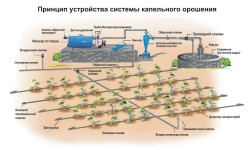 Drip irrigation for the greenhouse from the barrel is carried out in this way: on the territory of the agricultural section, a container filled with water rises above the soil surface at a distance of 1.5-2 meters. The barrel is mounted using a horizontal strong support. Optionally, you can connect the central highway or fill the tank with water manually. Some craftsmen organize water collection from the surface roofs nearby houses, buildings.
Drip irrigation for the greenhouse from the barrel is carried out in this way: on the territory of the agricultural section, a container filled with water rises above the soil surface at a distance of 1.5-2 meters. The barrel is mounted using a horizontal strong support. Optionally, you can connect the central highway or fill the tank with water manually. Some craftsmen organize water collection from the surface roofs nearby houses, buildings.
Be sure to install a filter that will provide fine water purification.
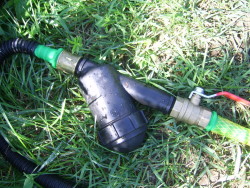 When determining the location of the barrel, you should know that direct sunlight negatively affects the water, can cause it to bloom and quickly heat up. During the day, the water will heat up, and at night the plants will receive soft irrigation with warm moisture.
When determining the location of the barrel, you should know that direct sunlight negatively affects the water, can cause it to bloom and quickly heat up. During the day, the water will heat up, and at night the plants will receive soft irrigation with warm moisture.
Installation of a faucet or water pipe is done in the lower part of the tank, using a special hole. For water supply it is better to buy light opaque plastic pipes with sealed walls. They are corrosion resistant, easily and simply connected to tees and various connectors.
Laying of main pipes is carried out in three basic ways:
- digging into the ground;
- mounting on supports;
- directly to the soil.
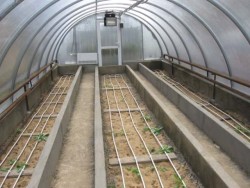 Of great importance is the first test run of the irrigation system - it happens pipe tightness check and connections, the necessary pressure is set for a uniform, high-quality water supply. The video shows how to do it competently.
Of great importance is the first test run of the irrigation system - it happens pipe tightness check and connections, the necessary pressure is set for a uniform, high-quality water supply. The video shows how to do it competently.
You will appreciate the possibility of quick assembly due to detachable connections. Also, this useful property is useful during storage of the system when it is not in use (all hoses are washed and blown).
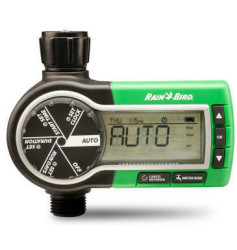 Irrigation adjustment can also be carried out manually - by opening or closing the water tap. Gardeners sometimes acquire an electronic timerwhich makes watering at the specified time and a certain volume of water. The life of the timer will be extended if an additional filter for cleaning is installed before it.
Irrigation adjustment can also be carried out manually - by opening or closing the water tap. Gardeners sometimes acquire an electronic timerwhich makes watering at the specified time and a certain volume of water. The life of the timer will be extended if an additional filter for cleaning is installed before it.
Drip irrigation for a greenhouse from a barrel can be combined with fertilizer application. To do this, fertilizer is added directly to the barrel for crops. Sometimes for these purposes an additional tank is used, which is installed parallel to the catchment barrel and connected to the system.
Greenhouse irrigation system maintenance
 Maintenance of the structure includes two main processes - seasonal storage (preservation) and de-preservation.
Maintenance of the structure includes two main processes - seasonal storage (preservation) and de-preservation.- In the autumn, the system is prepared for long-term storage - the health of all mechanisms is checked, pipes are washed with special means.
- Drainage tank cleaning. It is necessary to constantly monitor the purity and quality of the liquid in it, to prevent stagnation of water. And periodically perform a cleansing.
- Rinse filters. The purity of the water depends on the condition of the filter. To prevent clogging of the filters and ensure a good flow of water, you need to rinse them from time to time.
- Timely cleaning, blowing and subsequent proper preservation of the automatic irrigation system for the greenhouse guarantee a long service life.

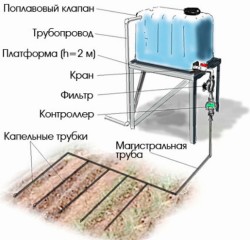
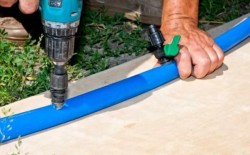
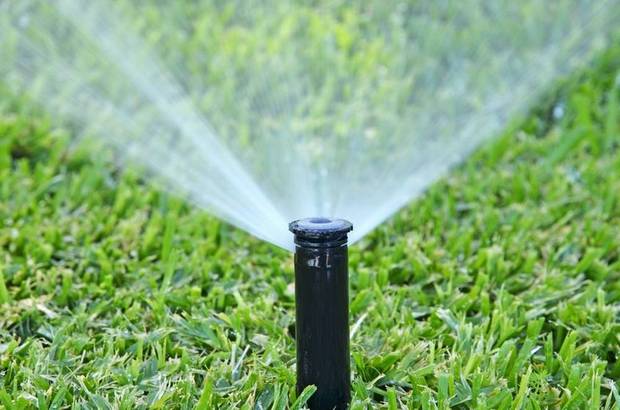
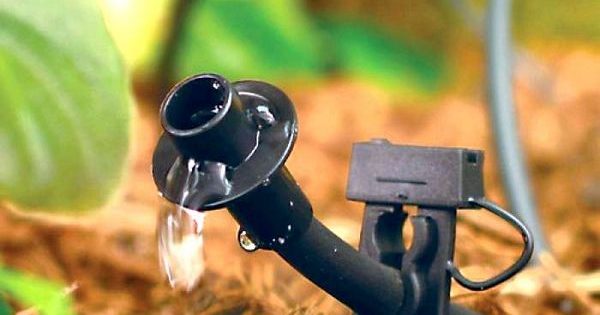
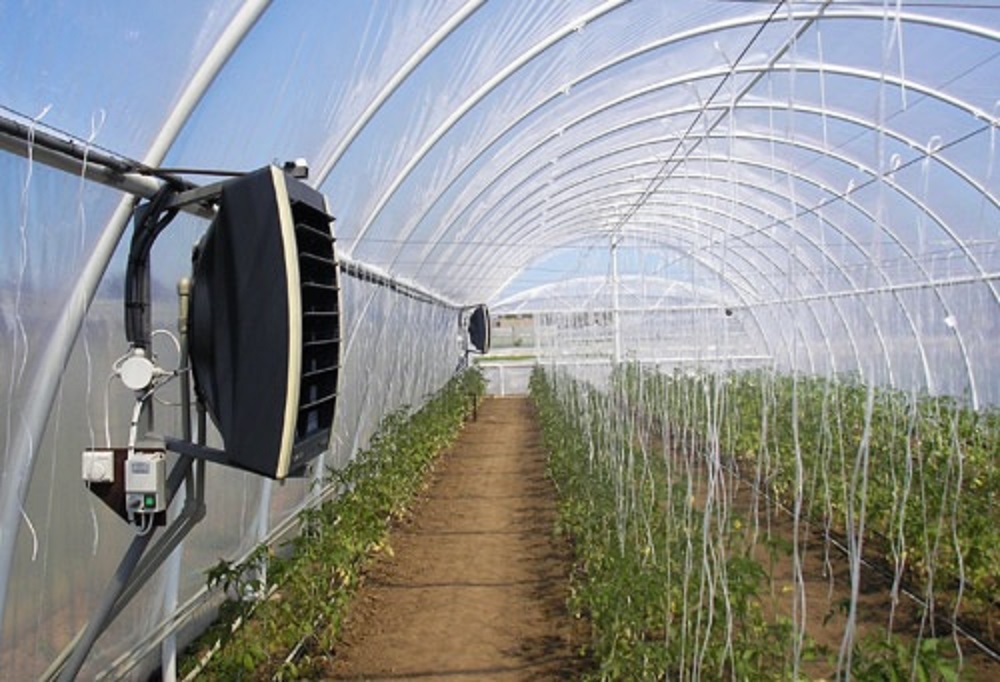
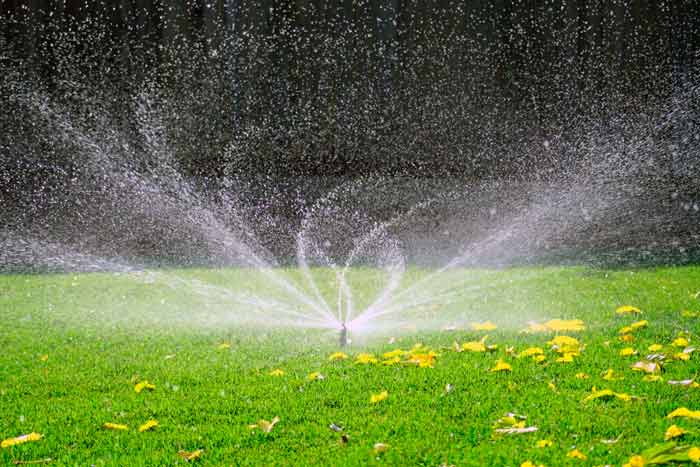
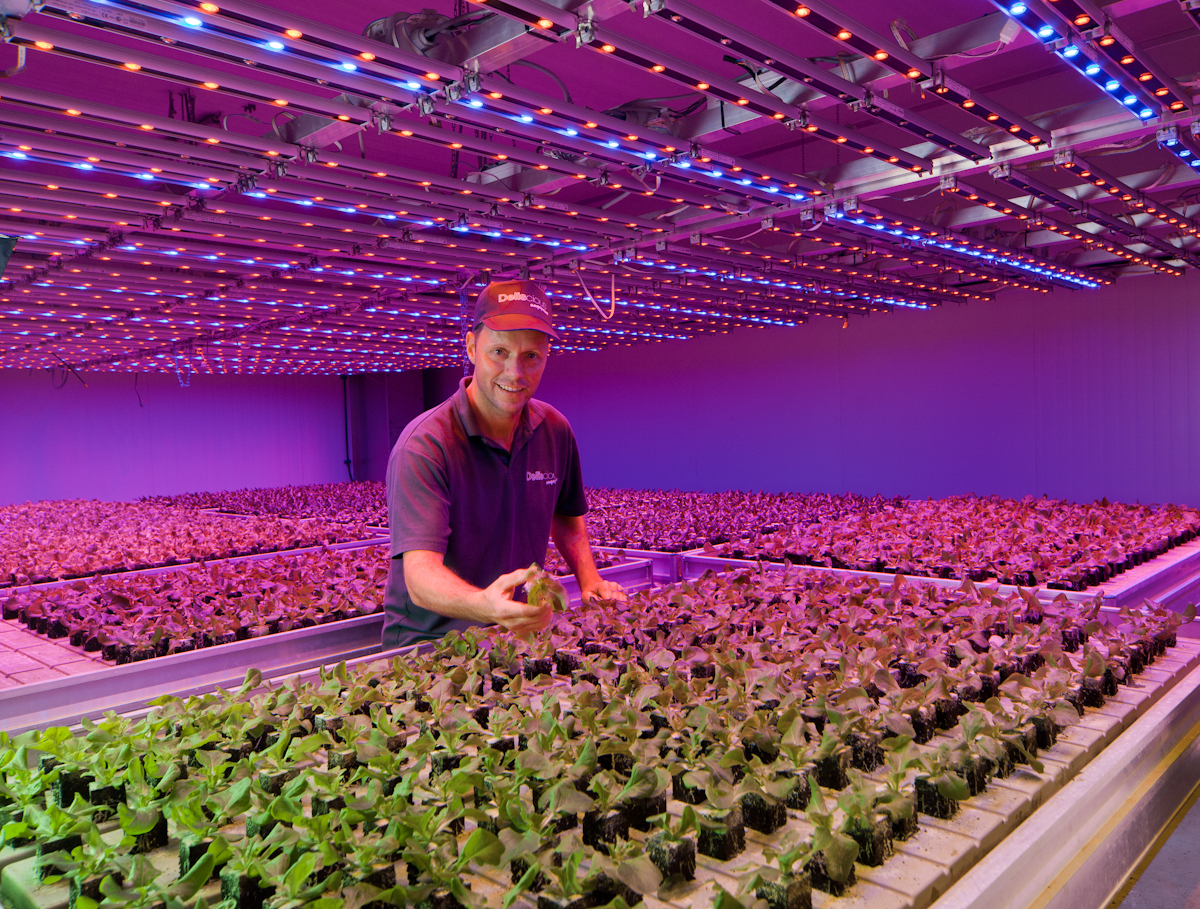

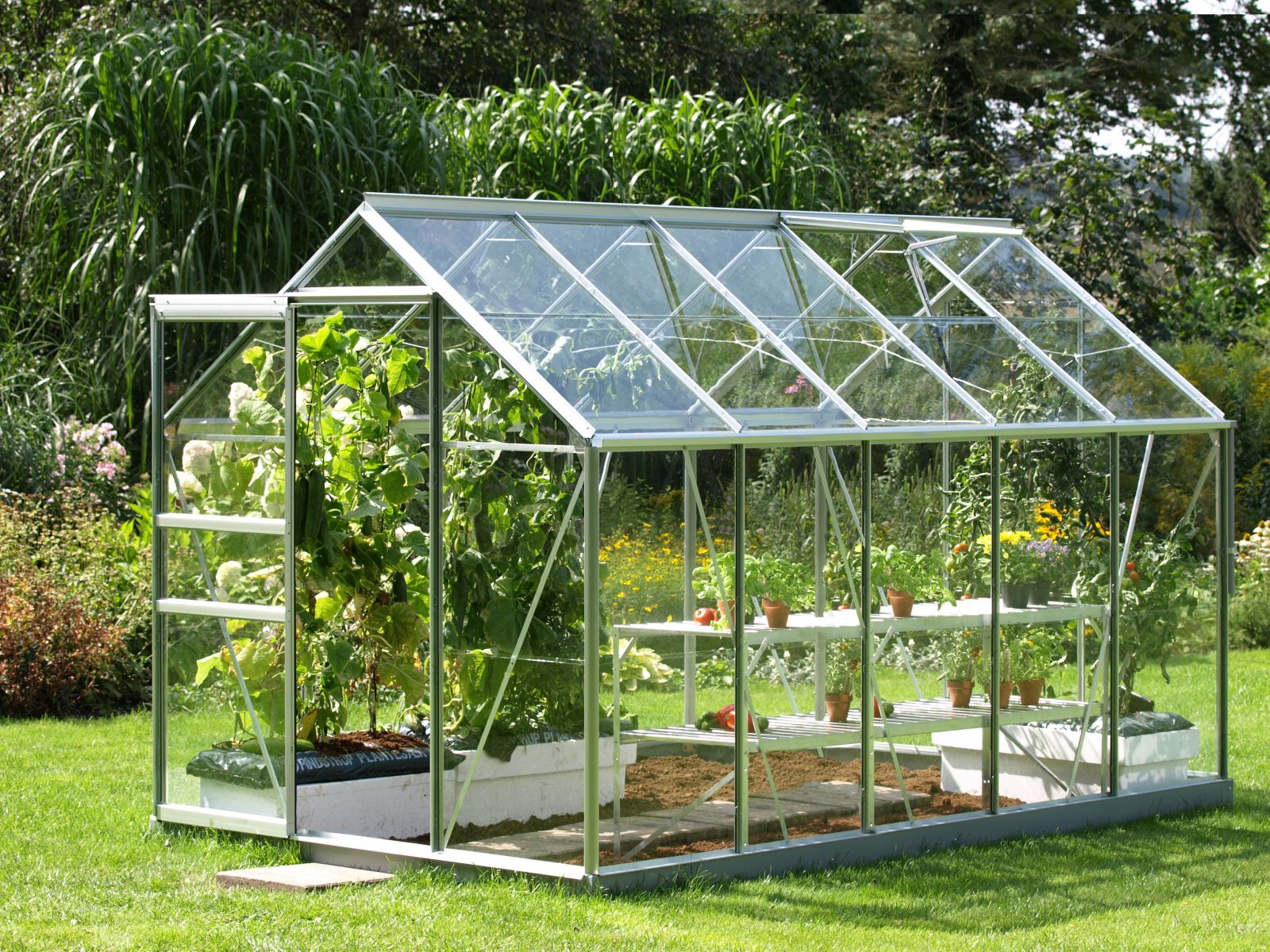
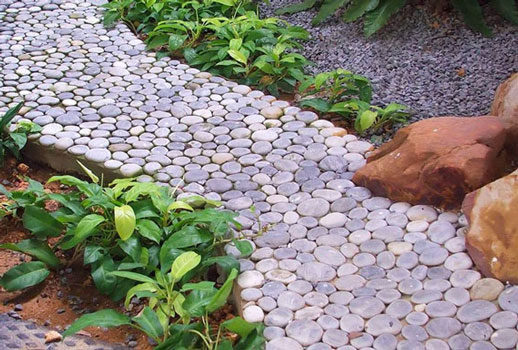
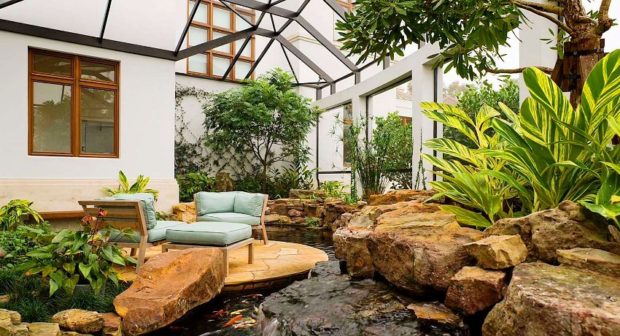
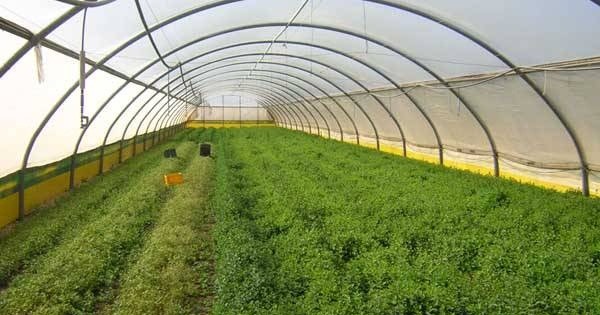
It would be interesting to read more about the foggy irrigation system. What is she like?